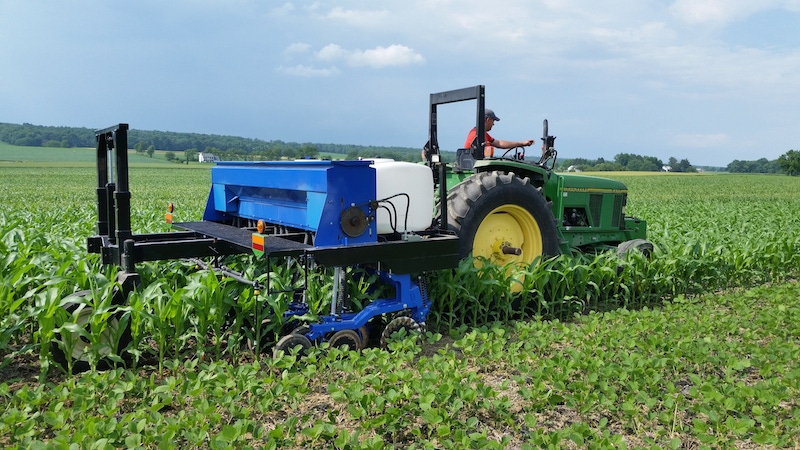July 14, 2014

It’s getting easier to establish cover crops on time, thanks to a Penn State interseeder. It also combines three trips into one: V4-V7 sidedress, herbicide application and cover crop seeding.
The head start is especially valuable for grass or legume cover-crop establishment in northern climates. The interseeder is a technologically enhanced version of a pre-World War II concept, says Penn State Agronomist Greg Roth, who led its development.
Many patriarchs remember broadcasting annual ryegrass in the 1940s during final cultivation, says Steve Groff, a Lancaster County, Pa., farmer who’s tested the interseeder for four years. He also owns Cover Crop Solutions, a purveyor of cover crop seed.
“This bridges biology with technology,” he says. “Time is money, and this Penn State multifunction machine extends the cover crop growing season by seeding during the sweet spot of establishment.” The cover crop emerges, goes dormant beneath the corn canopy, returns to life as the corn crop dries and then rebounds from sunlight access.
“Cover cropping is about seizing opportunity,” Groff adds. “I’ve gotten 230-bushel corn on interseeded field-length replicated trials, but worst case, I’ve had no yield hit from interseeding cover crops into standing corn.” He uses the interseeder to drill a mix of annual ryegrass, crimson clover (an summer annual) and tillage radish while sidedressing nitrogen and/or applying herbicide, depending on the situation. He’s not had any problem with stratification of differently sized cover-crop seeds.
“This simplifies a simple concept that is complicated to pull off,” Groff adds.
Capitalize on early cover-cropping system
Timely cover crop seeding is part of a larger system using a Penn State-developed interseeder.
Late June: Seed cover crop into V4-V7 standing corn, with optional sidedressing and/or postemerge herbicide application in the same pass. A wavy coulter cuts a narrow strip, double disk openers provide a seed furrow and packing wheels firm the slot and provide depth control. High-pressure UAN nozzles can sidedress N 4 inches from the corn row in the same pass.
Mid-July: The cover crop is established, but crop shading spurs its dormancy, reducing competition with the crop.
Fall: As corn dries and canopy is reduced, cover crops resume growth and continue until frost.
Spring: The farmer terminates the cover crop, which has anchored the soil through the erosion seasons, captured stray nitrates and banked future crop nutrients.
In continuous corn, interseeding is done in row middles the first year, and second-year corn is seeded next to the original corn rows, preventing planting in the dense cover crop. Any legume cover crops provide additional soil nitrogen.
If stalks have been removed or grazed, cover crops offset soil carbon loss.
About the Author(s)
You May Also Like




